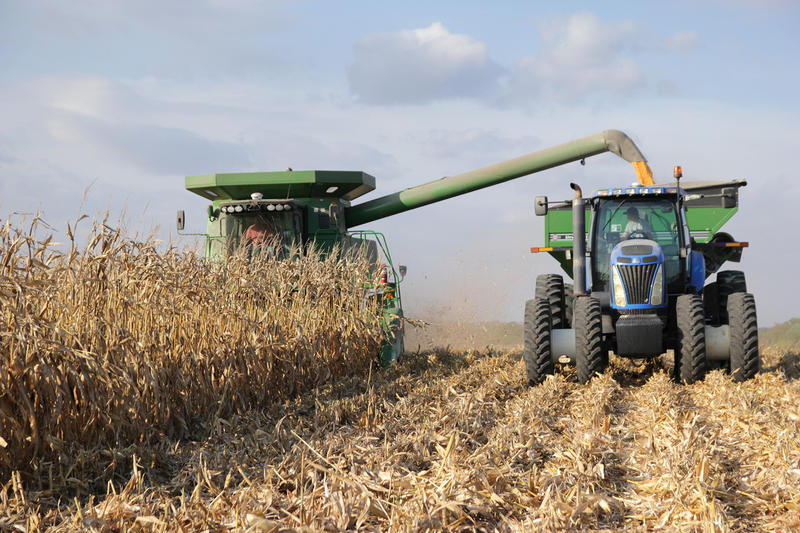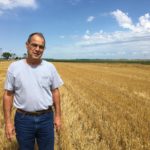Harvest Public Media: Farm Economy Downturn Prompts Fears Of A ‘Crisis’
By Peggy Lowe

An Illinois farmer harvests his corn crop in this file photo. Average net farm income has tumbled in recent years.
File: Abby Wendle / Harvest Public Media

Of all the expensive machinery Tom Giessel worked during the 2017 wheat harvest, his favorite sits in the office of his home.
It’s a microfilm machine, the kind found in a high school library. Giessel uses it for his work as the historian of the National Farmers Union, the nation’s second-largest farm group.
It’s the best investment he ever made, he says, and it sits in his office where faded bound books of old newspapers are stacked ceiling high and row after row of square white film boxes are packed into a cabinet.
Today’s history lesson: one of the worst farm depressions to ever hit the U.S., which struck during the 1980s.
“I remember in the early ‘80s what happened and how it happened,” Giessel says. “I went back, I’ve done some research, and tried to do some parallels and comparisons.”

Tom Giessel, 64, is a Kansas wheat farmer who harvest 1,800 acres of wheat in late June. He stands here in his field near Larned, Kansas.
Credit Peggy Lowe / KCUR 89.3
“There are still piles of grain from last year on the ground and we’re harvesting this year’s crop,” Giessel says. “So what does that tell you about over-supply?”
Fearing the worst, the National Farmers Union in May set up a farm crisis web page with info about loans, mediation, disaster relief and a suicide prevention hotline.
“We’re running on empty,” Giessel says. “The farm crisis is real.”
When it comes to the ag economy, however, “crisis” depends on who you ask.
Bill Watson, president of the Agribusiness Division of UMB Bank, a top-20 farm lender based in Kansas City, Missouri, said the term “crisis” is a personal concept that might be true for some but not all.
“A lot of people say: is this the same kind of thing that we were in in the ‘80s?,” Watson says. “My answer to that is clearly, ‘no.’”
Farmers accrued massive debt in the ‘80s and interest rates were very high, Watson says, with rates reaching up to 20-plus percent.
Yet he’ll admit that today’s farm income – cut in half since 2013, according to the U.S. Department of Agriculture – means many small farmers have not had a positive cash flow for several years. That could hurt small- or medium-sized farmers who have not reached the break-even point in that span.
“It’s not necessarily whether you fail cash flow,” Watson says. “It’s whether you fail making a payment. A payment on your equipment, a payment on your land, a payment to your landlord, That’s when things really start to change for you. So, I would submit to you that that’s a definition of a crisis.”
David Widmar, an ag economist at Purdue University in Indiana, prefers the term “adjustment” for the current situation. He agrees with Giessel and Watson that farm income is a problem. But he points out that in the ‘80s, farmers were facing tougher seasonsafter exports dried up thanks to the Soviet Union grain embargo.

Giessel sits in his office next to his computerized microfilm reader. He is the unofficial historian of the Kansas Farmers Union.
Credit Peggy Lowe / KCUR 89.3
There are worries, however, about a slide in exports. President Trump pulled the U.S. out of negotiations for the massive Trans-Pacific Partnership trade deal, which likely would have meant billions in ag exports for U.S. businesses. Trump has also proposed renegotiating NAFTA, which sees billions of dollars in U.S. ag exports to Canada and Mexico.
In central Kansas, Tom Giessel, 64, harvested 1,800 acres of wheat earlier this year. He is the fourth generation in his family to farm his land. But if the ag economy continues in what he sees as a crisis for the next few years, Giessel says he fears there will be a lot fewer guys like him in the future.
“I see us running out of money real fast,” he said. “It’s obvious.”